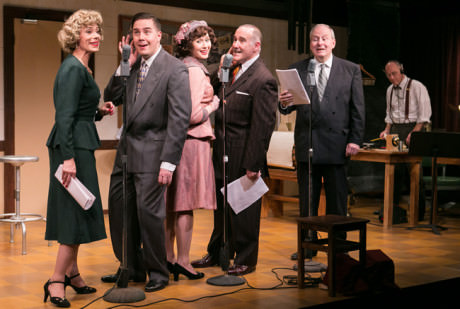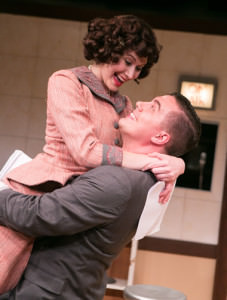Live Radio Play Injects Comedy into a Christmas Classic
Washington Stage Guild is presenting an entertaining radio play version of the 1940’s classic holiday film It’s a Wonderful Life. This retelling of a Christmas chestnut—made familiar to millions of television viewers over the years—is as funny and topical as if it had been written and directed today. Which, in fact, it has been.

Playwright Joe Landry has adapted It’s a Wonderful Life—itself adapted from Charles Dickens’ A Christmas Carol—into a lively, and sometimes hilariously funny, love song to the 1940s.
Unlike other adaptations—including the musical version just produced by the Reisterstown Theatre Project — this one is actually a play-within-a-play. And it pays to arrive early, since the fun begins well before curtain time.
In fact, there is no curtain. We walk into a theatre dominated by a brightly-lit set, settle into our seats, and slowly become aware of the sound engineer puttering around with his equipment. Played with comic intensity by Steven Carpenter, the straight-faced engineer fills a bucket of water for rain, rattles his wind-making instrument and tests the bells, whistles and chimes that make up just part of a wickedly funny domain created by Sound Designer Frank DiSalvo, Jr. and Steven Carpenter.
Carpenter is just one of the five gifted actors who amble onto the set before the play officially begins. Typical of the talent that made radio a generous employer of artists and musicians at the time, this group functions as a seamless ensemble, with most of the performers playing multiple roles. Switching back and forth between characters, they are basically stand-up comedians, creating a whirlwind of accents and comic expressions as they argue with themselves.
Vincent Clark, a veteran of Washington Stage Guild productions, is the genial MC who waves at us before the play begins and reminds us when to applaud. Clark plays so many roles that it’s hard to keep track. A versatile clown, he changes voices and facial expressions as he plays villains and drunks, a couple of bartenders, and a taxi driver.
He is also the heavenly administrator who reveals why George Bailey—the owner of the ‘wonderful life’—must not be allowed to give up. He also portrays the villain of the play: Henry Potter, which he plays with Scrooge-like malevolence. As the evil banker who would foreclose on every mortgage, Potter is a familiar type.
Similarly, Julie-Ann Elliott is the voice of nearly female in in the town, ranging from the village floozy to a switchboard operator, George’s mother and a maddening little girl.
Lawrence Redmond, another Stage Guild regular and two-time recipient of the Helen Hayes Award, plays the role of Clarence, the ‘ASC’—Angel Second Class—who is assigned to show George how much his life has meant to the town. It’s a heavenly performance.
The central characters—George Bailey and his loving wife Mary—are played by Joe Brack and Jennifer Donovan. Although both are newcomers to the Stage Guild, they have appeared at many theatres in the Washington area. Like Jimmy Stewart, who immortalized George in the often televised film version, Brack is an “aw shucks” kind of guy. As savior of the town’s Savings & Loan association, he is the unprepossessing nemesis of Wall Street greed. But he puts his own stamp on the role, especially in the second act, where his anger and rage help to turn things around.
As Mary, Donovan is an ingénue bursting with love and pride. She thinks nothing of casting off a wealthy suitor to marry George, then cancels her honeymoon to help the S&L stay open during the Crash of 1929.
Even adapted for radio, the sheer goodness of Mary and George would be hard to take if not for the audacity of the director, Laura Giannarelli, who has opted to stage this Christmas favorite as a spoof.
The injection of sight and sound gags is brilliant. In addition to characters mugging into their microphones or losing their places in the script, there are some wonderful touches, such as the use of men’s and women’s shoes, “walking” on a tabletop, to create the sound of footsteps.
Commercials, produced live by the performers themselves, immortalize long-gone outposts of Washington. The night I was there, jingles about Woodward & Lothrop and Reeves Bakery brought down the house.
Costumes, created by Debbie Kennedy, add to the sense of nostalgia. Imagine, if you can, a time when men wore jackets and ties, and women wore hats, gloves and stockings with seams.

The set, by Carl F. Gudenius, is an imagined replica of a radio studio in the 1940s. Tucked in one corner is a Christmas tree. It’s small, artificial and slightly crooked. A soundless cuckoo clock is hung from the ceiling, while the walls are festooned with sponsors’ photos and ads.
Marianne Meadows and Arthur Nordlie are responsible for the lighting and stage management, both of which are used effectively to keep the mushiness of the original film at bay.
The story behind the movie, released by RKO in late 1946, does a lot to clarify why It’s a Wonderful Life is still with us. Believe it or not, this film bombed when it first opened. Neither the critics nor the public liked it. And the FBI hated it. (According to a report, the film’s “negative portrayal of bankers” indicated Communist influence.)
Over the years, the film was forgotten. The studio failed to renew the copyright and the film passed into the public domain, where—as we all know—television stations began to show it, at no cost whatsoever, on Christmas Eve every year.
Ironically, the decision to adapt it into its current format—and to stage it as farce—may have restored the underlying fable. The more I laughed, the more I experienced a sense of recognition that the days of bank betrayals and mass foreclosures are not the stuff of fantasy.
Comedy often reinforces tragedy. I’m not the only member of the Stage Guild audience who left the theatre with a lump in my throat, and a sense that the George Baileys of the world need some protection—if not from angels, then maybe from us.
Running Time: Two hours, including one intermission.
It’s a Wonderful Life: A Live Radio Play plays through December 20, 2015 at the Washington Stage Guild performing at the Undercroft Theatre of Mount Vernon United Methodist Church – 900 Massachusetts Avenue, NW, in Washington, DC. For more information and for tickets, call (240) 582-0050 or purchase them online.




